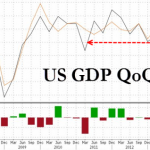This was going to be the year. Remember the predictions of 3% economic growth?
More recently, the consensus was 1.2% growth for the most recent quarter.
It turns out, though, that the economy has flat-lined, growing at a puny 0.1%, quarter over quarter. Even the 2% growth we’ve experienced throughout the 58 months of economic recovery we’ve had (see last week’s post) looks good in comparison to what we’re experiencing.
Keynesians, undaunted by being wrong 100% of the time, have been predicting for years that prosperity is just around the corner. The only thing around the corner, though, has been another corner, then another. It’s time to realize that we’ve been going in circles.
Growth of 0.1% is, of course, just a whisker’s width away from recession. Maybe that’s what’s around the corner.
Two areas of weakness were trade, which subtracted 80 basis points from GDP growth, and inventories, which subtracted 60 basis points. You may recall that in Q4 of 2013, when economists were talking about strengthening growth, it was because inventories were increasing.
Blame It on the Weather
When the economy is growing at glacial speed, it’s perhaps natural to blame it on the weather, which is what those who predicted strong growth are doing. Apparently, George Bush has been out of the White House too long to blame it on him.
If the weather is at fault, though, the pent-up demand that never materialized in Q1, combined with the previously projected 3% growth in Q2, should combine to create GDP growth higher than we’ve seen since the supply side days of President Reagan. We have not heard, though, of any economists adjusting their predictions for Q2.
Why not? Maybe they want to keep their jobs.
The silver lining – or maybe copper – is that spending on services surged in Q1. But Zerohedge reports that the surge was due to increased spending on healthcare and heating oil. Heating oil spending will, of course, not figure into Q2 growth. But if increased healthcare spending is a boost to the economy, we should be entering an economic golden age.
Supply Side vs. Demand Side
Speaking of supply side economics, it’s worth comparing the results that supply side policy produces with the results that demand-side policy produces. As The Wall Street Journal noted this week:
“In recent years the U.S. has experimented with demand-side stimulants on an unprecedented scale. Monetary stimulus involves pushing interest rates down to subsidize big borrowers (mainly governments and banks) at the expense of small savers (seniors). That was the reason the Fed shoved the federal-funds rate down to near zero. Even quadrupling the Fed’s assets had no clear and significant impact on the sluggish growth of nominal GDP.”
Budget deficits were an unprecedented 5.7% of potential GDP from 2009 to 2012. However, the good news is that the budget sequester has helped reduce the annual federal deficit to its lowest level in years and the Federal Reserve Board’s quantitative easing program is continuing to taper.
With demand-side stimulus subsiding, maybe we really have turned a corner and the economy will start growing again at a reasonable rate.
